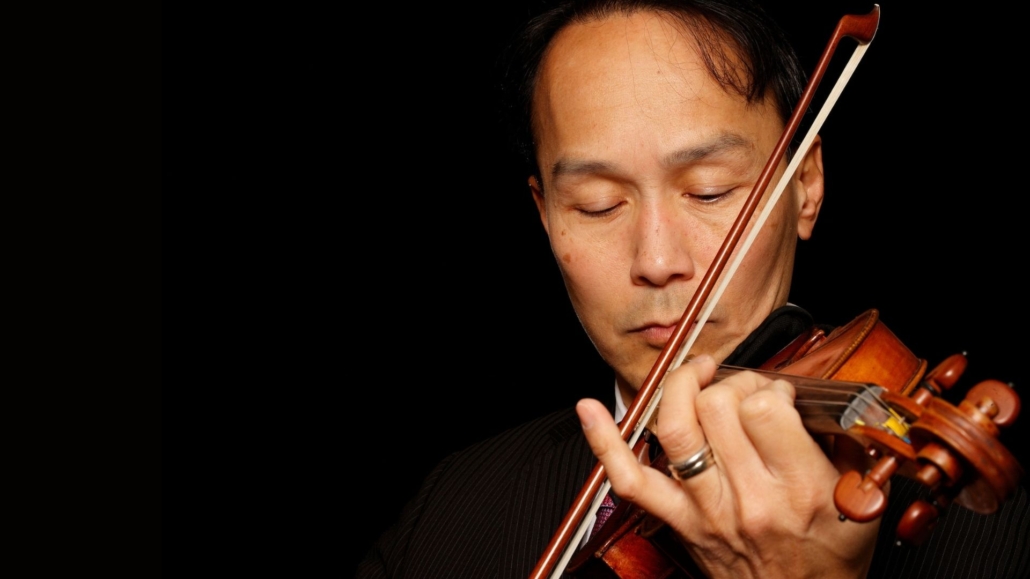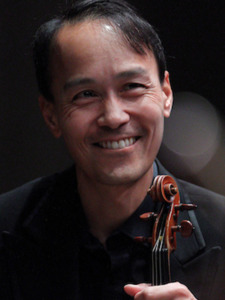Popular wisdom is that Ludwig van Beethoven’s Symphony No. 3 in E-flat major, often called the “Eroica” Symphony, is an exaltation of the “great man” theory of history—and in light of how Beethoven himself changed the course of Western music, there might be something to that interpretation. On a slightly smaller scale, the popular wisdom among violinists is that Béla Bartók’s Violin Concerto No. 2 is a fiendishly difficult undertaking—and one that requires a certain amount of bravery to undertake.
But there are other ways to consider this pairing, which we’ll hear in conjunction with the Korean composer Unsuk Chin’s Subito con forza.
“I’ve always felt that Beethoven and Bartók sit incredibly well together on a program,” says Victoria Symphony music director Christian Kluxen, who’ll be on the podium. “There’s something very natural about that pairing. They share this almost alchemical ability to take the simplest possible idea—a single interval, a small rhythmic gesture, a tiny cell—and build an entire world out of it. That economy of material, that kind of obsessive development and transformation, is something they both master in very different but equally powerful ways. They’re both incredibly structural and intellectual, but their music also breathes and sweats—it’s physical, emotional, and full of friction.
“There’s also the rhythmic drive and the sense of urgency they share,” Kluxen continues. “Their music never just exists—it’s always going somewhere, always in motion. And both have this earthy, grounded quality—Beethoven in his rustic dance movements and blunt humour, Bartók through his deep connection to folk music and that strange blend of rawness and refinement. And, maybe most of all, they both write music that feels like it’s working something out. Nothing is given; everything is earned.”
For Kluxen, the Violin Concerto doesn’t carry a direct connection to the Symphony No. 3. Bartok does not quote Beethoven, and while both artists drew on folk music for their thematic music, the hymns and work songs of the German peasantry reside in a very different place to the ultimately South Asian modes of Hungary’s Roma population. But there might be something to the notion that these two works bookend the Romantic era in music, Beethoven doing the groundwork that led to Schubert and Schumann and Brahms, among others, and Bartók taking both tonality and that “cellular” concept of music forward in a way that has powerfully impacted the music being written today.
That’s how violin soloist Terence Tam sees it, at any rate. “When I first came across this concerto as a kid, or a teenager, that’s exactly what I thought,” the Victoria Symphony concertmaster explains. “I thought ‘Oh, here’s the Bartók concerto. I don’t know much about Bartók, but everybody talks about it. It’s a big concerto, it’s difficult, let’s listen to it.’ And when you listen to it, it starts off kind of like a big Romantic concerto. The theme starts off as Romantic; you can immediately grasp on to it. You can kind of hum it almost right away. It’s got that type of catchiness. And it’s the same even with the theme of the second movement: it’s got a definite accessibility to it, where the average listener will not automatically think ‘Well, here’s clearly a 20th Century piece.’ And then we expect it to come back again, but when he brings back the themes, as he does, he kind of turns them on their heads. He reverses them, or he makes them upside-down, and then he starts messing with them even more. It gets more chromatic and transforms into something else, and we are left with no doubt that he’s really pushing the tonal boundaries of music, and he ranks with any other great 20th Century composer in that sense, like Berg or Schoenberg.”
If there is any heroism in this work, it lies in the courage required to negotiate its twists and surprises. “Some of the things that come to mind right away,” Tam explains, “are the numerous double stops and triple stops, which for string players are always a challenge. Bartók’s got many, many passages—and some of them fast passages—where he’s asking the violinist to play two strings or three strings at the same time. When we do that once or twice it’s fine, but he has ongoing passages, for many bars, where it’s just non-stop double stops, which is very tricky, technically. And of course there’s the tonality of the whole thing, which is that very distinct Bartók tonality. Even though it’s familiar to our ears if we listen to Bartók, it is its own language. For want of a better word, it’s in its own world.”
Beethoven created his own world, too.
“For me, the Symphony No. 3 is deeply personal,” says Kluxen. “It’s the first time Beethoven says, ‘Yes, I am BEETHOVEN.’ The first two symphonies are brilliant, no doubt—but compared to the Third, they feel like warm-ups. The Eroica is a statement. It’s like switching on the ignition of a great engine—you feel the explosion, and from there, there’s no turning back. No more politeness, no more formalities. Just pure momentum, risk, force. It’s wild and uncompromising and full of contradictions—and that’s exactly why it’s so alive.”
The same, he continues, can be said of Unsuk Chin. “Subito con forza is, I think, the perfect way to start the program,” Kluxen contends. “It’s a kind of an homage to Beethoven, but not in the glorifying, reverent sense. It doesn’t quote him to worship—it pokes, interrupts, explodes. It’s volatile, sharp, and full of wild gestures. In a way, it grabs hold of Beethoven’s spirit of sudden contrasts and unpredictable turns and brings that energy into the now. It’s not about repeating the past; it’s about using its force to say something new.
“It’s so tempting to assign big, universal meanings to these works, but these pieces were created by human beings,” the conductor adds. “Our motivations as artists are always personal and intimate, no matter how the world chooses to interpret what we leave behind. Beethoven dared to be fully, unapologetically himself in this work, and maybe that’s the real message: being yourself is the most heroic act of all.”
Notes by Alex Varty



 Christian Kluxen, conductor
Christian Kluxen, conductor Terence Tam, violin
Terence Tam, violin